International Financial Reporting: A Detailed Review of IASB & IFRS1
VerifiedAdded on 2023/06/17
|15
|3941
|384
Report
AI Summary
This report provides a comprehensive overview of International Financial Reporting Standards (IFRS), focusing on the IASB's conceptual framework and the first-time adoption of IFRS (IFRS1). Part A details the purpose of the IASB's framework, assumptions in financial statement preparation, concepts of capital maintenance, qualitative characteristics of financial statements, and the concept of materiality. Part B discusses IFRS16 related to leases and IAS7 concerning the statement of cash flows. The report explains key terms like 'first IFRS reporting period' and 'date of transition' as defined by IFRS1, highlighting the requirements for first-time adopters. It emphasizes the importance of IFRS in creating uniform, clear, and comparable financial statements for accurate investment performance and true valuation of companies. The analysis aims to enhance understanding of IFRS and its practical application in financial reporting.
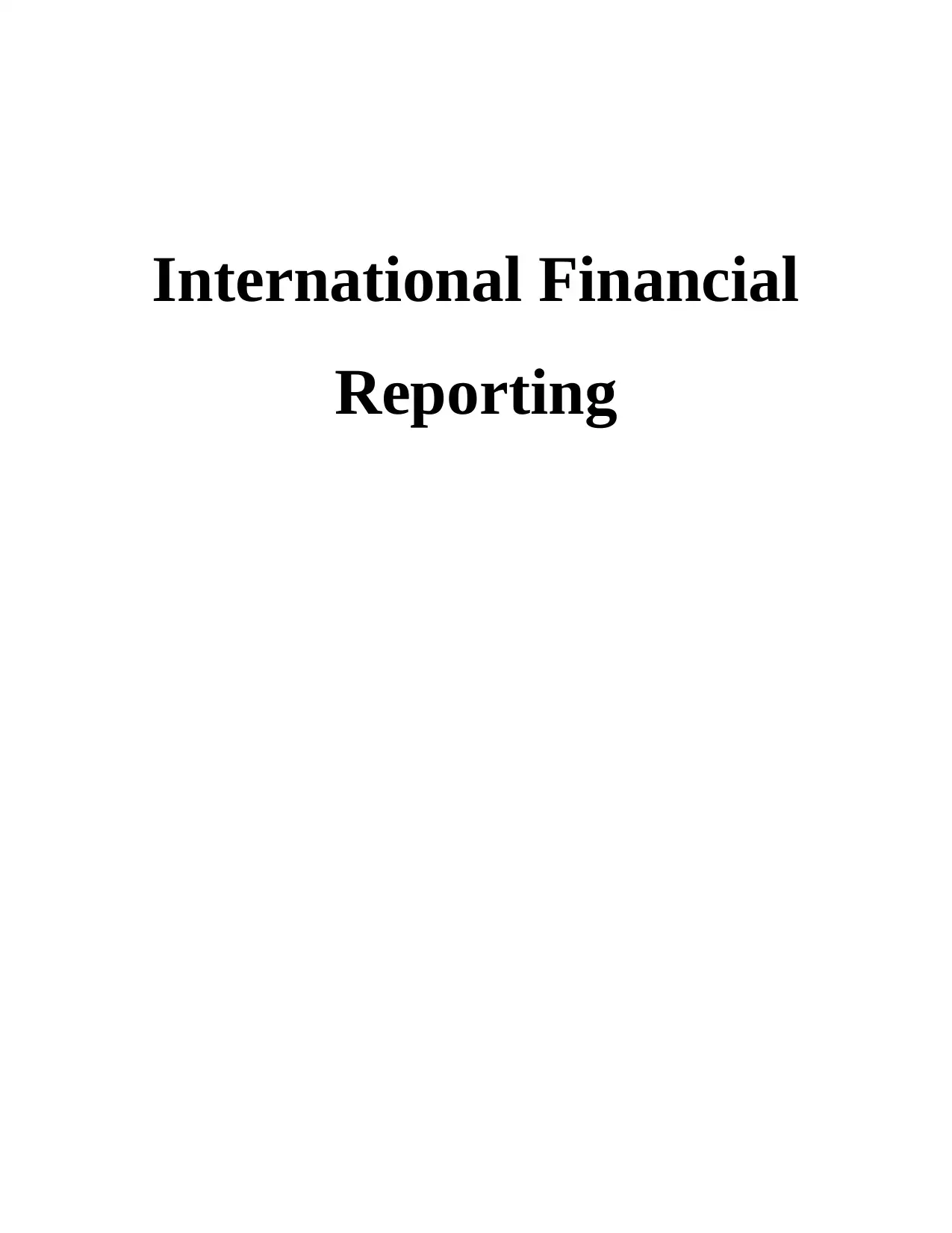
International Financial
Reporting
Reporting
Paraphrase This Document
Need a fresh take? Get an instant paraphrase of this document with our AI Paraphraser

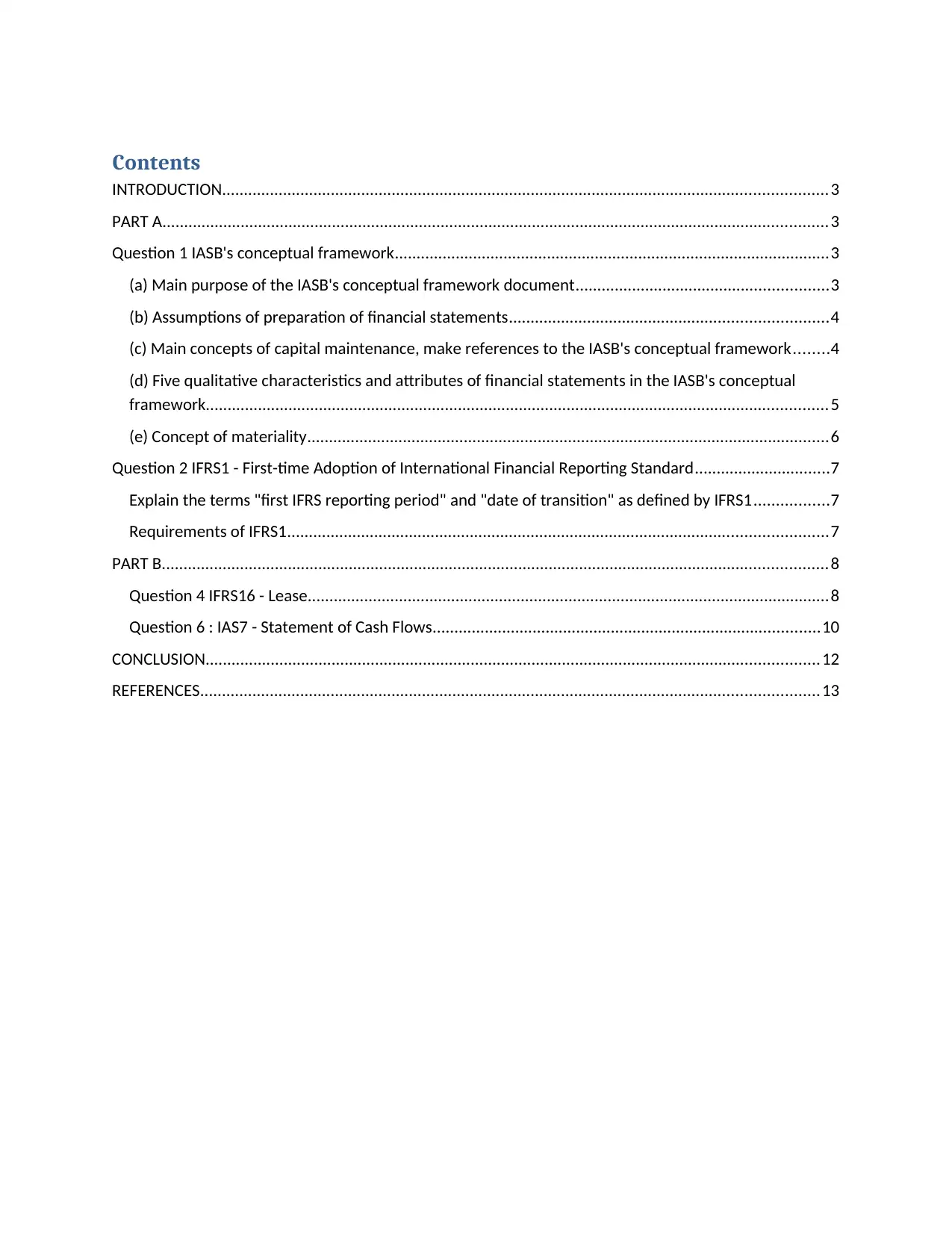
Contents
INTRODUCTION...........................................................................................................................................3
PART A.........................................................................................................................................................3
Question 1 IASB's conceptual framework....................................................................................................3
(a) Main purpose of the IASB's conceptual framework document..........................................................3
(b) Assumptions of preparation of financial statements.........................................................................4
(c) Main concepts of capital maintenance, make references to the IASB's conceptual framework........4
(d) Five qualitative characteristics and attributes of financial statements in the IASB's conceptual
framework...............................................................................................................................................5
(e) Concept of materiality........................................................................................................................6
Question 2 IFRS1 - First-time Adoption of International Financial Reporting Standard...............................7
Explain the terms "first IFRS reporting period" and "date of transition" as defined by IFRS1.................7
Requirements of IFRS1............................................................................................................................7
PART B.........................................................................................................................................................8
Question 4 IFRS16 - Lease........................................................................................................................8
Question 6 : IAS7 - Statement of Cash Flows.........................................................................................10
CONCLUSION.............................................................................................................................................12
REFERENCES..............................................................................................................................................13
INTRODUCTION...........................................................................................................................................3
PART A.........................................................................................................................................................3
Question 1 IASB's conceptual framework....................................................................................................3
(a) Main purpose of the IASB's conceptual framework document..........................................................3
(b) Assumptions of preparation of financial statements.........................................................................4
(c) Main concepts of capital maintenance, make references to the IASB's conceptual framework........4
(d) Five qualitative characteristics and attributes of financial statements in the IASB's conceptual
framework...............................................................................................................................................5
(e) Concept of materiality........................................................................................................................6
Question 2 IFRS1 - First-time Adoption of International Financial Reporting Standard...............................7
Explain the terms "first IFRS reporting period" and "date of transition" as defined by IFRS1.................7
Requirements of IFRS1............................................................................................................................7
PART B.........................................................................................................................................................8
Question 4 IFRS16 - Lease........................................................................................................................8
Question 6 : IAS7 - Statement of Cash Flows.........................................................................................10
CONCLUSION.............................................................................................................................................12
REFERENCES..............................................................................................................................................13
⊘ This is a preview!⊘
Do you want full access?
Subscribe today to unlock all pages.

Trusted by 1+ million students worldwide
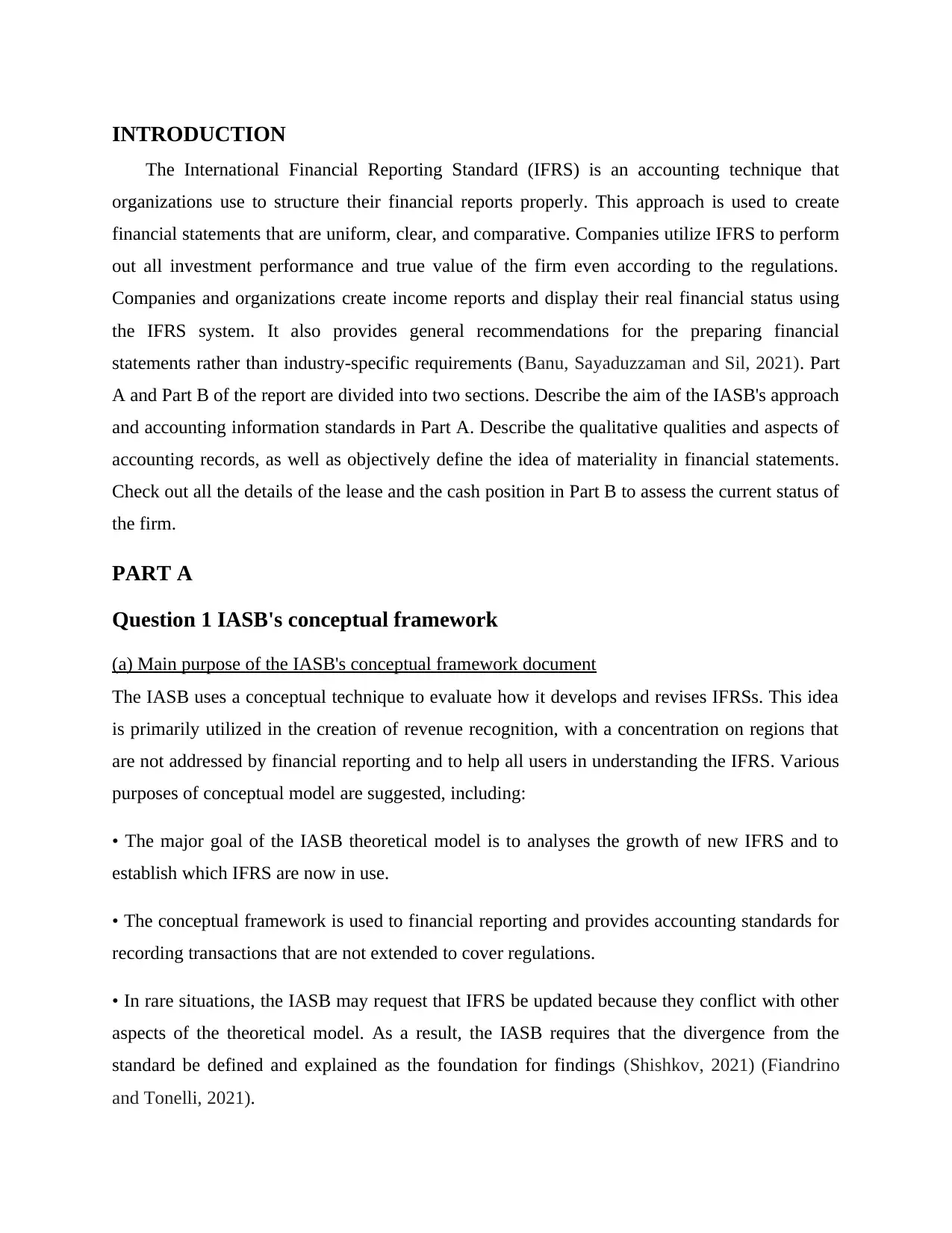
INTRODUCTION
The International Financial Reporting Standard (IFRS) is an accounting technique that
organizations use to structure their financial reports properly. This approach is used to create
financial statements that are uniform, clear, and comparative. Companies utilize IFRS to perform
out all investment performance and true value of the firm even according to the regulations.
Companies and organizations create income reports and display their real financial status using
the IFRS system. It also provides general recommendations for the preparing financial
statements rather than industry-specific requirements (Banu, Sayaduzzaman and Sil, 2021). Part
A and Part B of the report are divided into two sections. Describe the aim of the IASB's approach
and accounting information standards in Part A. Describe the qualitative qualities and aspects of
accounting records, as well as objectively define the idea of materiality in financial statements.
Check out all the details of the lease and the cash position in Part B to assess the current status of
the firm.
PART A
Question 1 IASB's conceptual framework
(a) Main purpose of the IASB's conceptual framework document
The IASB uses a conceptual technique to evaluate how it develops and revises IFRSs. This idea
is primarily utilized in the creation of revenue recognition, with a concentration on regions that
are not addressed by financial reporting and to help all users in understanding the IFRS. Various
purposes of conceptual model are suggested, including:
• The major goal of the IASB theoretical model is to analyses the growth of new IFRS and to
establish which IFRS are now in use.
• The conceptual framework is used to financial reporting and provides accounting standards for
recording transactions that are not extended to cover regulations.
• In rare situations, the IASB may request that IFRS be updated because they conflict with other
aspects of the theoretical model. As a result, the IASB requires that the divergence from the
standard be defined and explained as the foundation for findings (Shishkov, 2021) (Fiandrino
and Tonelli, 2021).
The International Financial Reporting Standard (IFRS) is an accounting technique that
organizations use to structure their financial reports properly. This approach is used to create
financial statements that are uniform, clear, and comparative. Companies utilize IFRS to perform
out all investment performance and true value of the firm even according to the regulations.
Companies and organizations create income reports and display their real financial status using
the IFRS system. It also provides general recommendations for the preparing financial
statements rather than industry-specific requirements (Banu, Sayaduzzaman and Sil, 2021). Part
A and Part B of the report are divided into two sections. Describe the aim of the IASB's approach
and accounting information standards in Part A. Describe the qualitative qualities and aspects of
accounting records, as well as objectively define the idea of materiality in financial statements.
Check out all the details of the lease and the cash position in Part B to assess the current status of
the firm.
PART A
Question 1 IASB's conceptual framework
(a) Main purpose of the IASB's conceptual framework document
The IASB uses a conceptual technique to evaluate how it develops and revises IFRSs. This idea
is primarily utilized in the creation of revenue recognition, with a concentration on regions that
are not addressed by financial reporting and to help all users in understanding the IFRS. Various
purposes of conceptual model are suggested, including:
• The major goal of the IASB theoretical model is to analyses the growth of new IFRS and to
establish which IFRS are now in use.
• The conceptual framework is used to financial reporting and provides accounting standards for
recording transactions that are not extended to cover regulations.
• In rare situations, the IASB may request that IFRS be updated because they conflict with other
aspects of the theoretical model. As a result, the IASB requires that the divergence from the
standard be defined and explained as the foundation for findings (Shishkov, 2021) (Fiandrino
and Tonelli, 2021).
Paraphrase This Document
Need a fresh take? Get an instant paraphrase of this document with our AI Paraphraser
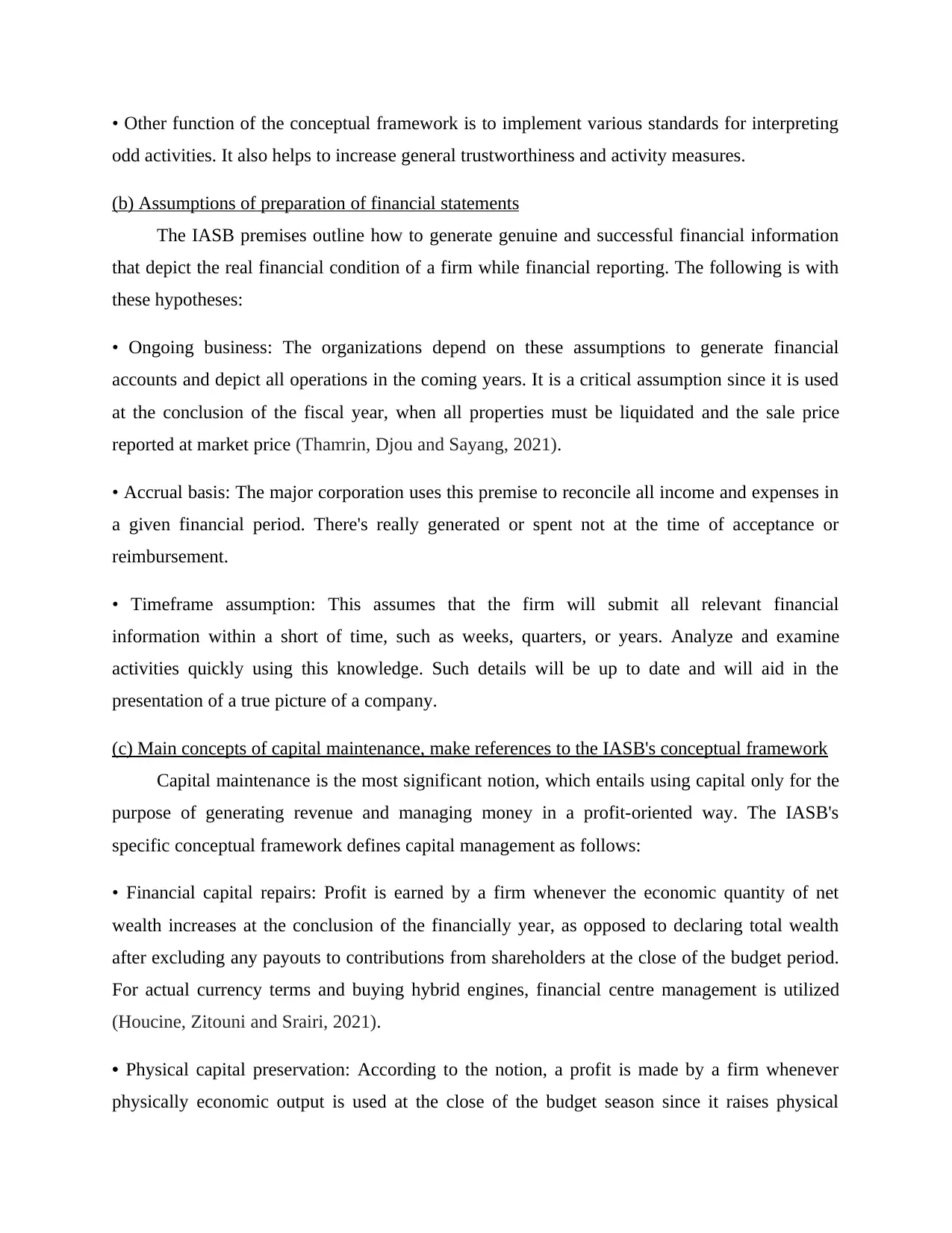
• Other function of the conceptual framework is to implement various standards for interpreting
odd activities. It also helps to increase general trustworthiness and activity measures.
(b) Assumptions of preparation of financial statements
The IASB premises outline how to generate genuine and successful financial information
that depict the real financial condition of a firm while financial reporting. The following is with
these hypotheses:
• Ongoing business: The organizations depend on these assumptions to generate financial
accounts and depict all operations in the coming years. It is a critical assumption since it is used
at the conclusion of the fiscal year, when all properties must be liquidated and the sale price
reported at market price (Thamrin, Djou and Sayang, 2021).
• Accrual basis: The major corporation uses this premise to reconcile all income and expenses in
a given financial period. There's really generated or spent not at the time of acceptance or
reimbursement.
• Timeframe assumption: This assumes that the firm will submit all relevant financial
information within a short of time, such as weeks, quarters, or years. Analyze and examine
activities quickly using this knowledge. Such details will be up to date and will aid in the
presentation of a true picture of a company.
(c) Main concepts of capital maintenance, make references to the IASB's conceptual framework
Capital maintenance is the most significant notion, which entails using capital only for the
purpose of generating revenue and managing money in a profit-oriented way. The IASB's
specific conceptual framework defines capital management as follows:
• Financial capital repairs: Profit is earned by a firm whenever the economic quantity of net
wealth increases at the conclusion of the financially year, as opposed to declaring total wealth
after excluding any payouts to contributions from shareholders at the close of the budget period.
For actual currency terms and buying hybrid engines, financial centre management is utilized
(Houcine, Zitouni and Srairi, 2021).
• Physical capital preservation: According to the notion, a profit is made by a firm whenever
physically economic output is used at the close of the budget season since it raises physical
odd activities. It also helps to increase general trustworthiness and activity measures.
(b) Assumptions of preparation of financial statements
The IASB premises outline how to generate genuine and successful financial information
that depict the real financial condition of a firm while financial reporting. The following is with
these hypotheses:
• Ongoing business: The organizations depend on these assumptions to generate financial
accounts and depict all operations in the coming years. It is a critical assumption since it is used
at the conclusion of the fiscal year, when all properties must be liquidated and the sale price
reported at market price (Thamrin, Djou and Sayang, 2021).
• Accrual basis: The major corporation uses this premise to reconcile all income and expenses in
a given financial period. There's really generated or spent not at the time of acceptance or
reimbursement.
• Timeframe assumption: This assumes that the firm will submit all relevant financial
information within a short of time, such as weeks, quarters, or years. Analyze and examine
activities quickly using this knowledge. Such details will be up to date and will aid in the
presentation of a true picture of a company.
(c) Main concepts of capital maintenance, make references to the IASB's conceptual framework
Capital maintenance is the most significant notion, which entails using capital only for the
purpose of generating revenue and managing money in a profit-oriented way. The IASB's
specific conceptual framework defines capital management as follows:
• Financial capital repairs: Profit is earned by a firm whenever the economic quantity of net
wealth increases at the conclusion of the financially year, as opposed to declaring total wealth
after excluding any payouts to contributions from shareholders at the close of the budget period.
For actual currency terms and buying hybrid engines, financial centre management is utilized
(Houcine, Zitouni and Srairi, 2021).
• Physical capital preservation: According to the notion, a profit is made by a firm whenever
physically economic output is used at the close of the budget season since it raises physical
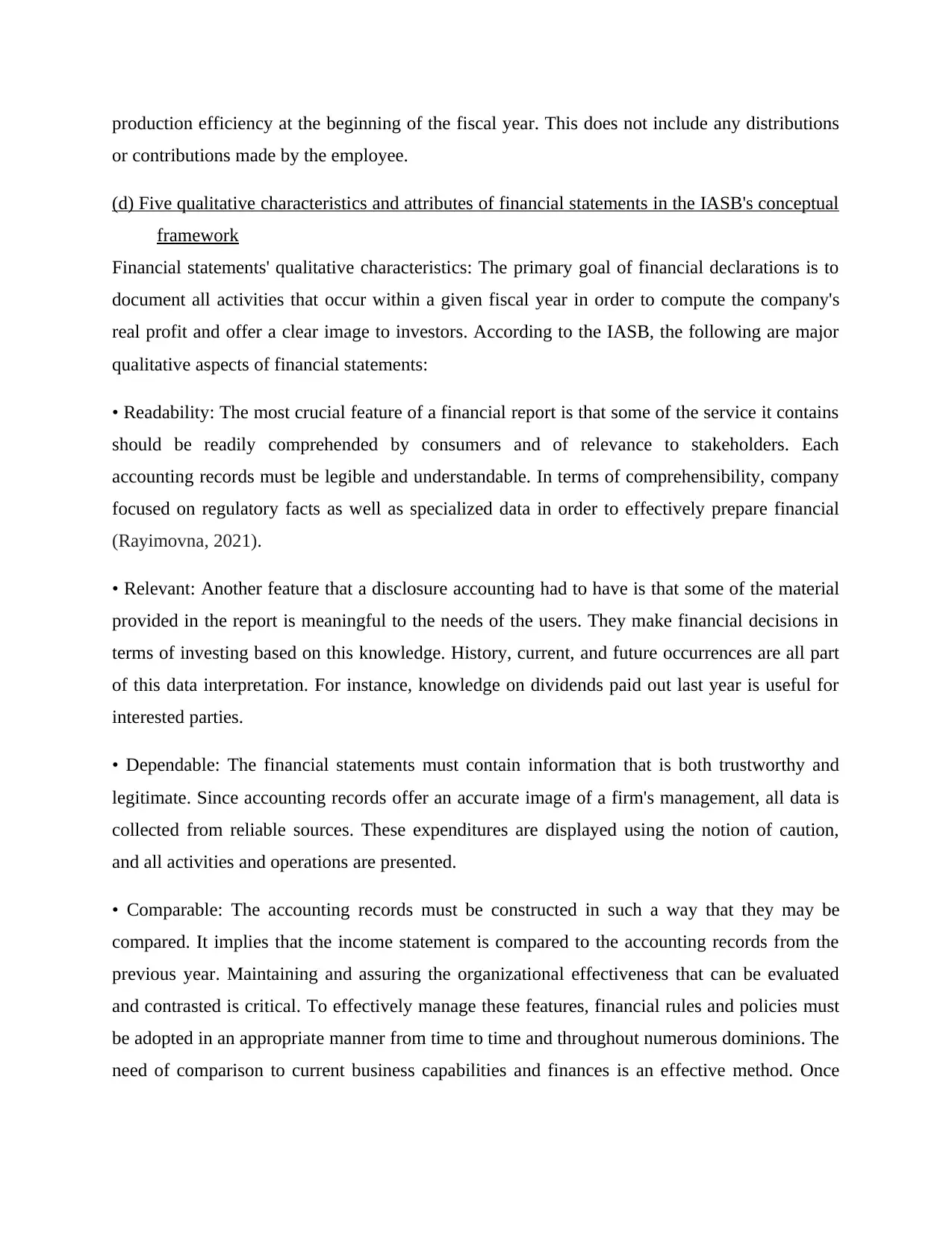
production efficiency at the beginning of the fiscal year. This does not include any distributions
or contributions made by the employee.
(d) Five qualitative characteristics and attributes of financial statements in the IASB's conceptual
framework
Financial statements' qualitative characteristics: The primary goal of financial declarations is to
document all activities that occur within a given fiscal year in order to compute the company's
real profit and offer a clear image to investors. According to the IASB, the following are major
qualitative aspects of financial statements:
• Readability: The most crucial feature of a financial report is that some of the service it contains
should be readily comprehended by consumers and of relevance to stakeholders. Each
accounting records must be legible and understandable. In terms of comprehensibility, company
focused on regulatory facts as well as specialized data in order to effectively prepare financial
(Rayimovna, 2021).
• Relevant: Another feature that a disclosure accounting had to have is that some of the material
provided in the report is meaningful to the needs of the users. They make financial decisions in
terms of investing based on this knowledge. History, current, and future occurrences are all part
of this data interpretation. For instance, knowledge on dividends paid out last year is useful for
interested parties.
• Dependable: The financial statements must contain information that is both trustworthy and
legitimate. Since accounting records offer an accurate image of a firm's management, all data is
collected from reliable sources. These expenditures are displayed using the notion of caution,
and all activities and operations are presented.
• Comparable: The accounting records must be constructed in such a way that they may be
compared. It implies that the income statement is compared to the accounting records from the
previous year. Maintaining and assuring the organizational effectiveness that can be evaluated
and contrasted is critical. To effectively manage these features, financial rules and policies must
be adopted in an appropriate manner from time to time and throughout numerous dominions. The
need of comparison to current business capabilities and finances is an effective method. Once
or contributions made by the employee.
(d) Five qualitative characteristics and attributes of financial statements in the IASB's conceptual
framework
Financial statements' qualitative characteristics: The primary goal of financial declarations is to
document all activities that occur within a given fiscal year in order to compute the company's
real profit and offer a clear image to investors. According to the IASB, the following are major
qualitative aspects of financial statements:
• Readability: The most crucial feature of a financial report is that some of the service it contains
should be readily comprehended by consumers and of relevance to stakeholders. Each
accounting records must be legible and understandable. In terms of comprehensibility, company
focused on regulatory facts as well as specialized data in order to effectively prepare financial
(Rayimovna, 2021).
• Relevant: Another feature that a disclosure accounting had to have is that some of the material
provided in the report is meaningful to the needs of the users. They make financial decisions in
terms of investing based on this knowledge. History, current, and future occurrences are all part
of this data interpretation. For instance, knowledge on dividends paid out last year is useful for
interested parties.
• Dependable: The financial statements must contain information that is both trustworthy and
legitimate. Since accounting records offer an accurate image of a firm's management, all data is
collected from reliable sources. These expenditures are displayed using the notion of caution,
and all activities and operations are presented.
• Comparable: The accounting records must be constructed in such a way that they may be
compared. It implies that the income statement is compared to the accounting records from the
previous year. Maintaining and assuring the organizational effectiveness that can be evaluated
and contrasted is critical. To effectively manage these features, financial rules and policies must
be adopted in an appropriate manner from time to time and throughout numerous dominions. The
need of comparison to current business capabilities and finances is an effective method. Once
⊘ This is a preview!⊘
Do you want full access?
Subscribe today to unlock all pages.

Trusted by 1+ million students worldwide
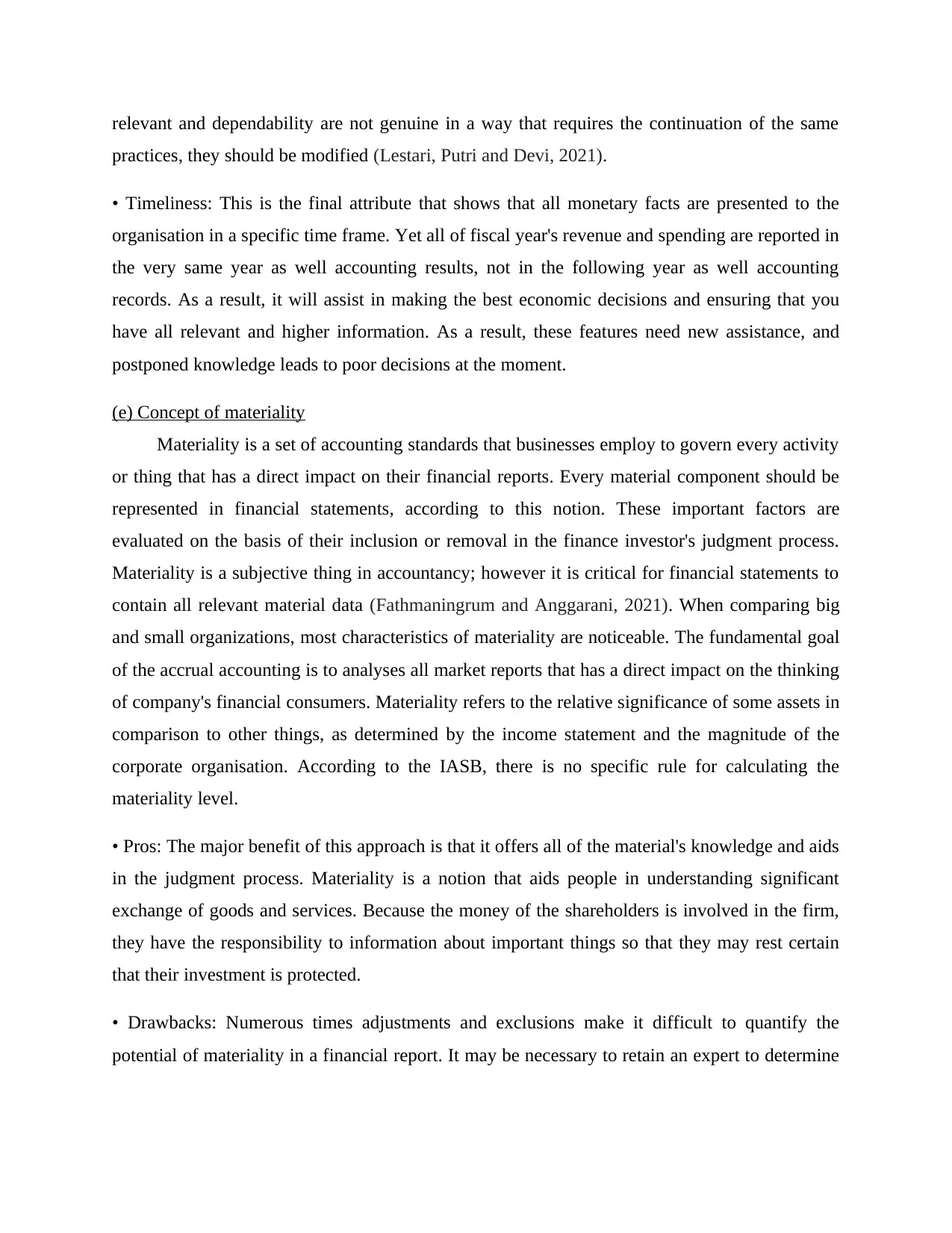
relevant and dependability are not genuine in a way that requires the continuation of the same
practices, they should be modified (Lestari, Putri and Devi, 2021).
• Timeliness: This is the final attribute that shows that all monetary facts are presented to the
organisation in a specific time frame. Yet all of fiscal year's revenue and spending are reported in
the very same year as well accounting results, not in the following year as well accounting
records. As a result, it will assist in making the best economic decisions and ensuring that you
have all relevant and higher information. As a result, these features need new assistance, and
postponed knowledge leads to poor decisions at the moment.
(e) Concept of materiality
Materiality is a set of accounting standards that businesses employ to govern every activity
or thing that has a direct impact on their financial reports. Every material component should be
represented in financial statements, according to this notion. These important factors are
evaluated on the basis of their inclusion or removal in the finance investor's judgment process.
Materiality is a subjective thing in accountancy; however it is critical for financial statements to
contain all relevant material data (Fathmaningrum and Anggarani, 2021). When comparing big
and small organizations, most characteristics of materiality are noticeable. The fundamental goal
of the accrual accounting is to analyses all market reports that has a direct impact on the thinking
of company's financial consumers. Materiality refers to the relative significance of some assets in
comparison to other things, as determined by the income statement and the magnitude of the
corporate organisation. According to the IASB, there is no specific rule for calculating the
materiality level.
• Pros: The major benefit of this approach is that it offers all of the material's knowledge and aids
in the judgment process. Materiality is a notion that aids people in understanding significant
exchange of goods and services. Because the money of the shareholders is involved in the firm,
they have the responsibility to information about important things so that they may rest certain
that their investment is protected.
• Drawbacks: Numerous times adjustments and exclusions make it difficult to quantify the
potential of materiality in a financial report. It may be necessary to retain an expert to determine
practices, they should be modified (Lestari, Putri and Devi, 2021).
• Timeliness: This is the final attribute that shows that all monetary facts are presented to the
organisation in a specific time frame. Yet all of fiscal year's revenue and spending are reported in
the very same year as well accounting results, not in the following year as well accounting
records. As a result, it will assist in making the best economic decisions and ensuring that you
have all relevant and higher information. As a result, these features need new assistance, and
postponed knowledge leads to poor decisions at the moment.
(e) Concept of materiality
Materiality is a set of accounting standards that businesses employ to govern every activity
or thing that has a direct impact on their financial reports. Every material component should be
represented in financial statements, according to this notion. These important factors are
evaluated on the basis of their inclusion or removal in the finance investor's judgment process.
Materiality is a subjective thing in accountancy; however it is critical for financial statements to
contain all relevant material data (Fathmaningrum and Anggarani, 2021). When comparing big
and small organizations, most characteristics of materiality are noticeable. The fundamental goal
of the accrual accounting is to analyses all market reports that has a direct impact on the thinking
of company's financial consumers. Materiality refers to the relative significance of some assets in
comparison to other things, as determined by the income statement and the magnitude of the
corporate organisation. According to the IASB, there is no specific rule for calculating the
materiality level.
• Pros: The major benefit of this approach is that it offers all of the material's knowledge and aids
in the judgment process. Materiality is a notion that aids people in understanding significant
exchange of goods and services. Because the money of the shareholders is involved in the firm,
they have the responsibility to information about important things so that they may rest certain
that their investment is protected.
• Drawbacks: Numerous times adjustments and exclusions make it difficult to quantify the
potential of materiality in a financial report. It may be necessary to retain an expert to determine
Paraphrase This Document
Need a fresh take? Get an instant paraphrase of this document with our AI Paraphraser
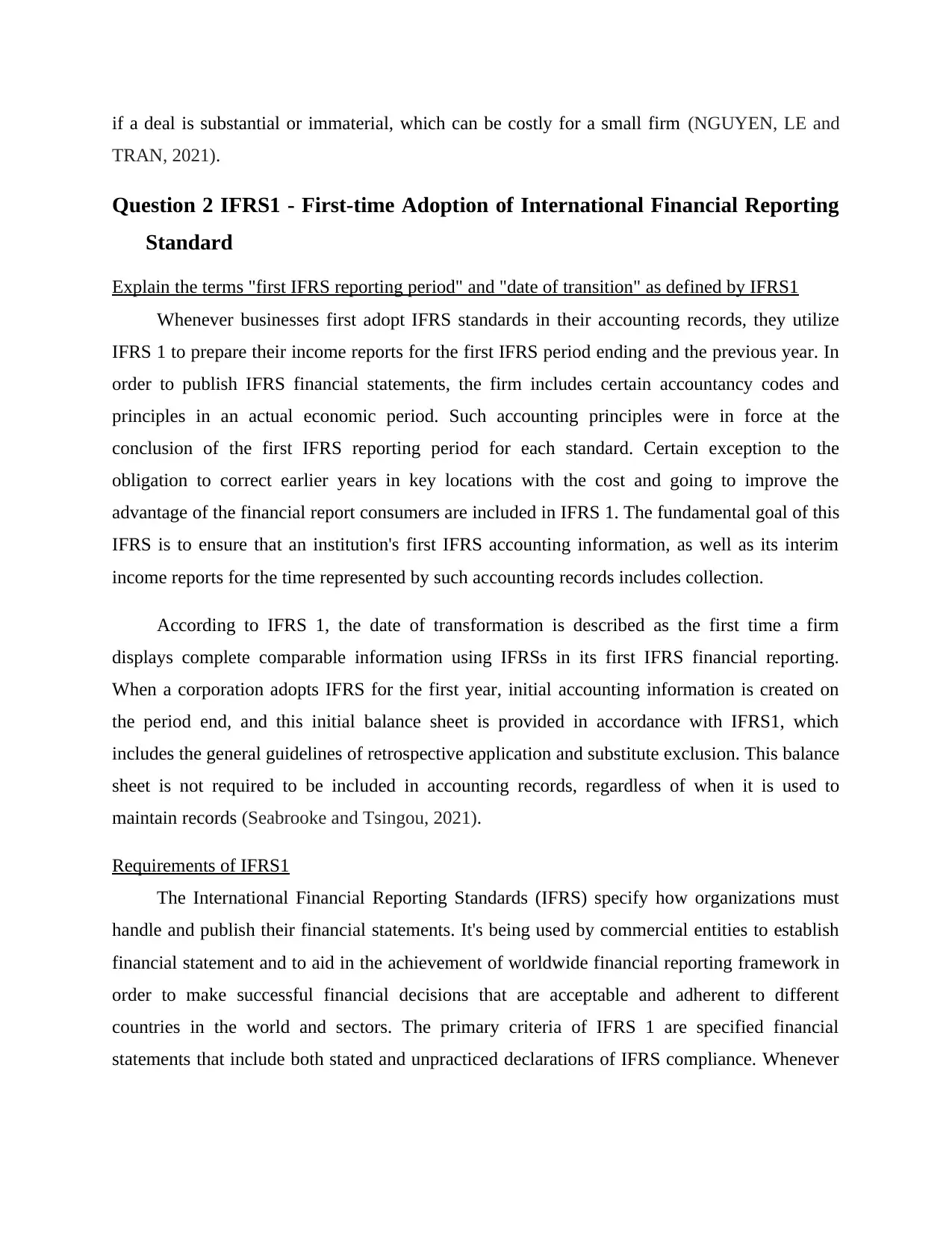
if a deal is substantial or immaterial, which can be costly for a small firm (NGUYEN, LE and
TRAN, 2021).
Question 2 IFRS1 - First-time Adoption of International Financial Reporting
Standard
Explain the terms "first IFRS reporting period" and "date of transition" as defined by IFRS1
Whenever businesses first adopt IFRS standards in their accounting records, they utilize
IFRS 1 to prepare their income reports for the first IFRS period ending and the previous year. In
order to publish IFRS financial statements, the firm includes certain accountancy codes and
principles in an actual economic period. Such accounting principles were in force at the
conclusion of the first IFRS reporting period for each standard. Certain exception to the
obligation to correct earlier years in key locations with the cost and going to improve the
advantage of the financial report consumers are included in IFRS 1. The fundamental goal of this
IFRS is to ensure that an institution's first IFRS accounting information, as well as its interim
income reports for the time represented by such accounting records includes collection.
According to IFRS 1, the date of transformation is described as the first time a firm
displays complete comparable information using IFRSs in its first IFRS financial reporting.
When a corporation adopts IFRS for the first year, initial accounting information is created on
the period end, and this initial balance sheet is provided in accordance with IFRS1, which
includes the general guidelines of retrospective application and substitute exclusion. This balance
sheet is not required to be included in accounting records, regardless of when it is used to
maintain records (Seabrooke and Tsingou, 2021).
Requirements of IFRS1
The International Financial Reporting Standards (IFRS) specify how organizations must
handle and publish their financial statements. It's being used by commercial entities to establish
financial statement and to aid in the achievement of worldwide financial reporting framework in
order to make successful financial decisions that are acceptable and adherent to different
countries in the world and sectors. The primary criteria of IFRS 1 are specified financial
statements that include both stated and unpracticed declarations of IFRS compliance. Whenever
TRAN, 2021).
Question 2 IFRS1 - First-time Adoption of International Financial Reporting
Standard
Explain the terms "first IFRS reporting period" and "date of transition" as defined by IFRS1
Whenever businesses first adopt IFRS standards in their accounting records, they utilize
IFRS 1 to prepare their income reports for the first IFRS period ending and the previous year. In
order to publish IFRS financial statements, the firm includes certain accountancy codes and
principles in an actual economic period. Such accounting principles were in force at the
conclusion of the first IFRS reporting period for each standard. Certain exception to the
obligation to correct earlier years in key locations with the cost and going to improve the
advantage of the financial report consumers are included in IFRS 1. The fundamental goal of this
IFRS is to ensure that an institution's first IFRS accounting information, as well as its interim
income reports for the time represented by such accounting records includes collection.
According to IFRS 1, the date of transformation is described as the first time a firm
displays complete comparable information using IFRSs in its first IFRS financial reporting.
When a corporation adopts IFRS for the first year, initial accounting information is created on
the period end, and this initial balance sheet is provided in accordance with IFRS1, which
includes the general guidelines of retrospective application and substitute exclusion. This balance
sheet is not required to be included in accounting records, regardless of when it is used to
maintain records (Seabrooke and Tsingou, 2021).
Requirements of IFRS1
The International Financial Reporting Standards (IFRS) specify how organizations must
handle and publish their financial statements. It's being used by commercial entities to establish
financial statement and to aid in the achievement of worldwide financial reporting framework in
order to make successful financial decisions that are acceptable and adherent to different
countries in the world and sectors. The primary criteria of IFRS 1 are specified financial
statements that include both stated and unpracticed declarations of IFRS compliance. Whenever
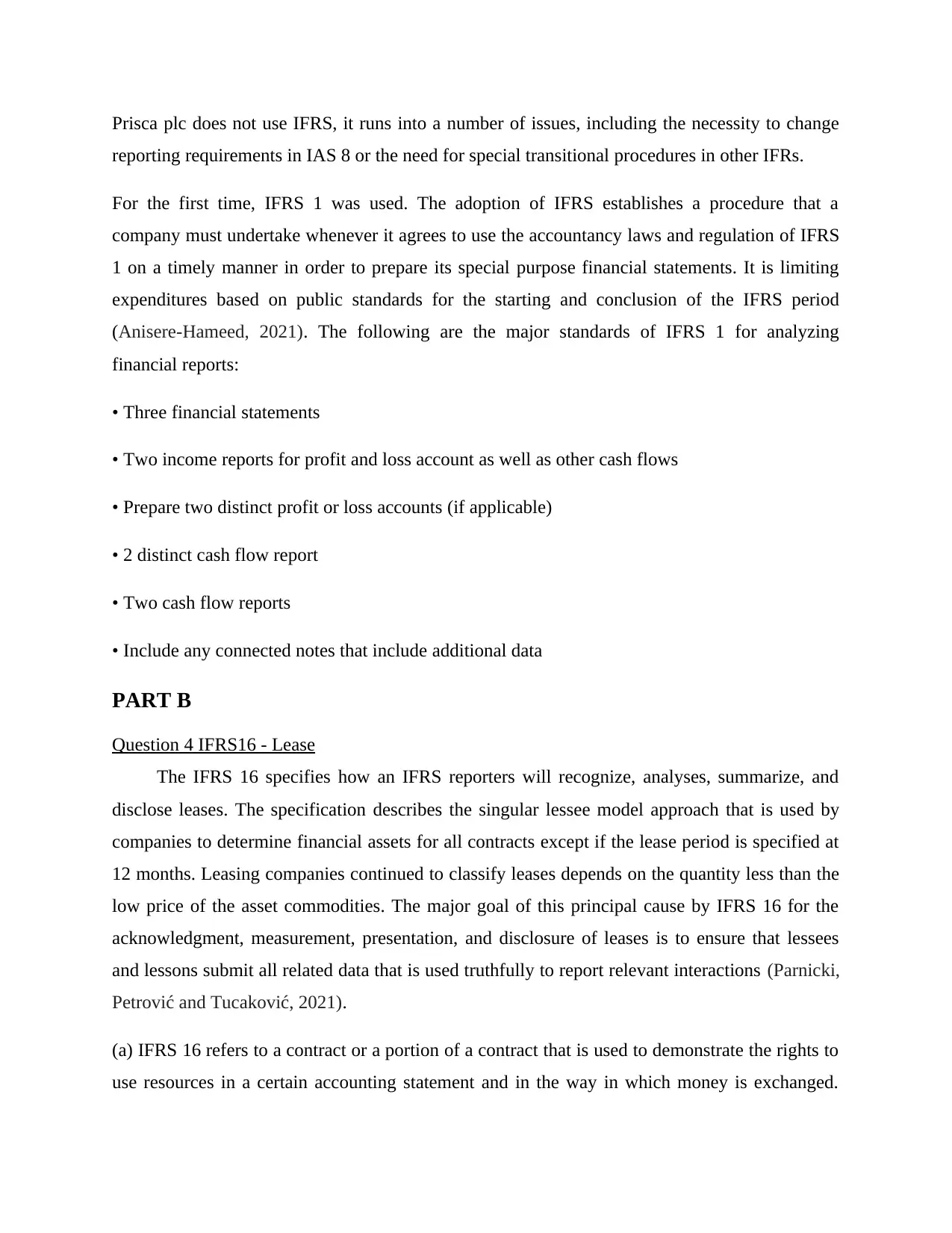
Prisca plc does not use IFRS, it runs into a number of issues, including the necessity to change
reporting requirements in IAS 8 or the need for special transitional procedures in other IFRs.
For the first time, IFRS 1 was used. The adoption of IFRS establishes a procedure that a
company must undertake whenever it agrees to use the accountancy laws and regulation of IFRS
1 on a timely manner in order to prepare its special purpose financial statements. It is limiting
expenditures based on public standards for the starting and conclusion of the IFRS period
(Anisere-Hameed, 2021). The following are the major standards of IFRS 1 for analyzing
financial reports:
• Three financial statements
• Two income reports for profit and loss account as well as other cash flows
• Prepare two distinct profit or loss accounts (if applicable)
• 2 distinct cash flow report
• Two cash flow reports
• Include any connected notes that include additional data
PART B
Question 4 IFRS16 - Lease
The IFRS 16 specifies how an IFRS reporters will recognize, analyses, summarize, and
disclose leases. The specification describes the singular lessee model approach that is used by
companies to determine financial assets for all contracts except if the lease period is specified at
12 months. Leasing companies continued to classify leases depends on the quantity less than the
low price of the asset commodities. The major goal of this principal cause by IFRS 16 for the
acknowledgment, measurement, presentation, and disclosure of leases is to ensure that lessees
and lessons submit all related data that is used truthfully to report relevant interactions (Parnicki,
Petrović and Tucaković, 2021).
(a) IFRS 16 refers to a contract or a portion of a contract that is used to demonstrate the rights to
use resources in a certain accounting statement and in the way in which money is exchanged.
reporting requirements in IAS 8 or the need for special transitional procedures in other IFRs.
For the first time, IFRS 1 was used. The adoption of IFRS establishes a procedure that a
company must undertake whenever it agrees to use the accountancy laws and regulation of IFRS
1 on a timely manner in order to prepare its special purpose financial statements. It is limiting
expenditures based on public standards for the starting and conclusion of the IFRS period
(Anisere-Hameed, 2021). The following are the major standards of IFRS 1 for analyzing
financial reports:
• Three financial statements
• Two income reports for profit and loss account as well as other cash flows
• Prepare two distinct profit or loss accounts (if applicable)
• 2 distinct cash flow report
• Two cash flow reports
• Include any connected notes that include additional data
PART B
Question 4 IFRS16 - Lease
The IFRS 16 specifies how an IFRS reporters will recognize, analyses, summarize, and
disclose leases. The specification describes the singular lessee model approach that is used by
companies to determine financial assets for all contracts except if the lease period is specified at
12 months. Leasing companies continued to classify leases depends on the quantity less than the
low price of the asset commodities. The major goal of this principal cause by IFRS 16 for the
acknowledgment, measurement, presentation, and disclosure of leases is to ensure that lessees
and lessons submit all related data that is used truthfully to report relevant interactions (Parnicki,
Petrović and Tucaković, 2021).
(a) IFRS 16 refers to a contract or a portion of a contract that is used to demonstrate the rights to
use resources in a certain accounting statement and in the way in which money is exchanged.
⊘ This is a preview!⊘
Do you want full access?
Subscribe today to unlock all pages.

Trusted by 1+ million students worldwide
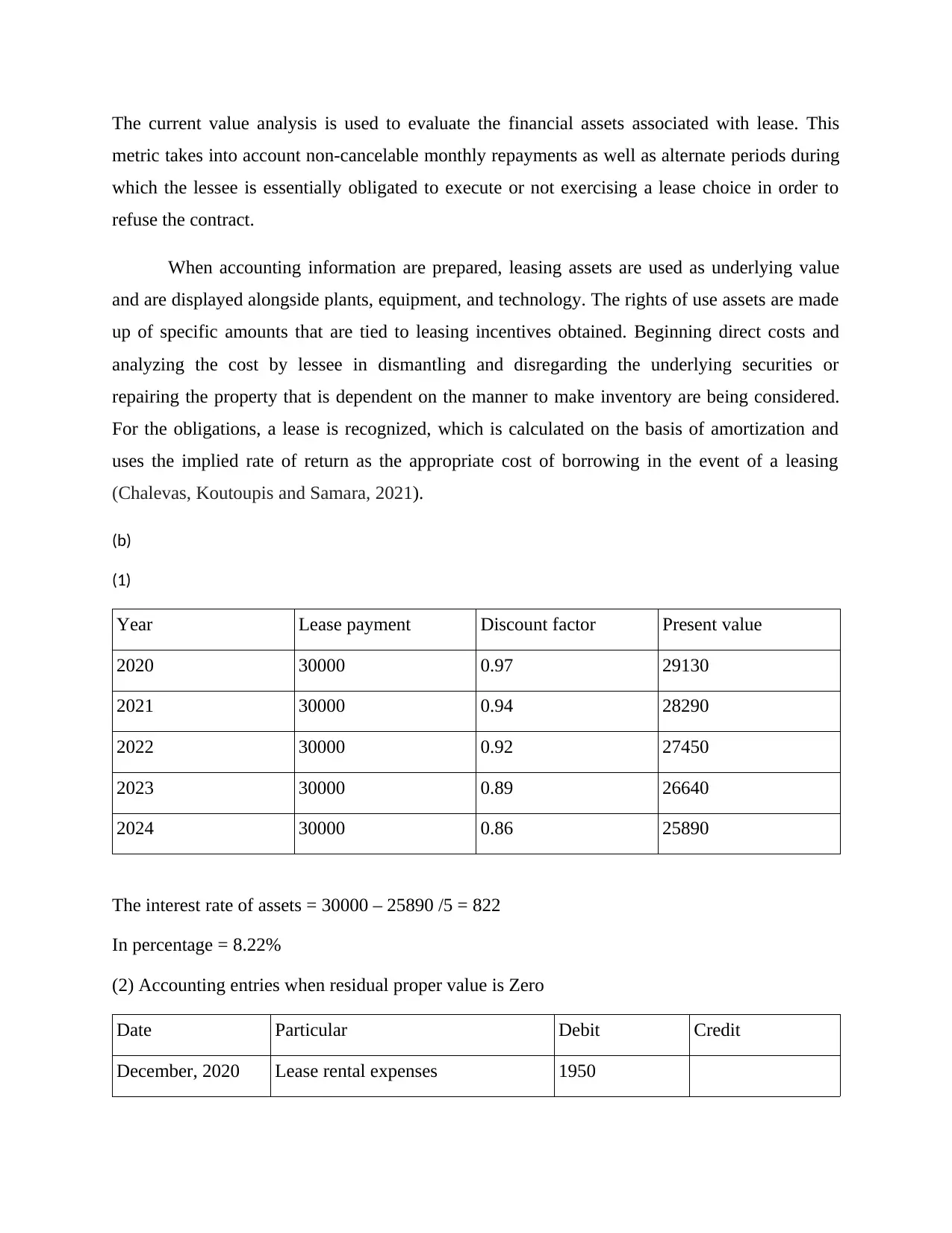
The current value analysis is used to evaluate the financial assets associated with lease. This
metric takes into account non-cancelable monthly repayments as well as alternate periods during
which the lessee is essentially obligated to execute or not exercising a lease choice in order to
refuse the contract.
When accounting information are prepared, leasing assets are used as underlying value
and are displayed alongside plants, equipment, and technology. The rights of use assets are made
up of specific amounts that are tied to leasing incentives obtained. Beginning direct costs and
analyzing the cost by lessee in dismantling and disregarding the underlying securities or
repairing the property that is dependent on the manner to make inventory are being considered.
For the obligations, a lease is recognized, which is calculated on the basis of amortization and
uses the implied rate of return as the appropriate cost of borrowing in the event of a leasing
(Chalevas, Koutoupis and Samara, 2021).
(b)
(1)
Year Lease payment Discount factor Present value
2020 30000 0.97 29130
2021 30000 0.94 28290
2022 30000 0.92 27450
2023 30000 0.89 26640
2024 30000 0.86 25890
The interest rate of assets = 30000 – 25890 /5 = 822
In percentage = 8.22%
(2) Accounting entries when residual proper value is Zero
Date Particular Debit Credit
December, 2020 Lease rental expenses 1950
metric takes into account non-cancelable monthly repayments as well as alternate periods during
which the lessee is essentially obligated to execute or not exercising a lease choice in order to
refuse the contract.
When accounting information are prepared, leasing assets are used as underlying value
and are displayed alongside plants, equipment, and technology. The rights of use assets are made
up of specific amounts that are tied to leasing incentives obtained. Beginning direct costs and
analyzing the cost by lessee in dismantling and disregarding the underlying securities or
repairing the property that is dependent on the manner to make inventory are being considered.
For the obligations, a lease is recognized, which is calculated on the basis of amortization and
uses the implied rate of return as the appropriate cost of borrowing in the event of a leasing
(Chalevas, Koutoupis and Samara, 2021).
(b)
(1)
Year Lease payment Discount factor Present value
2020 30000 0.97 29130
2021 30000 0.94 28290
2022 30000 0.92 27450
2023 30000 0.89 26640
2024 30000 0.86 25890
The interest rate of assets = 30000 – 25890 /5 = 822
In percentage = 8.22%
(2) Accounting entries when residual proper value is Zero
Date Particular Debit Credit
December, 2020 Lease rental expenses 1950
Paraphrase This Document
Need a fresh take? Get an instant paraphrase of this document with our AI Paraphraser
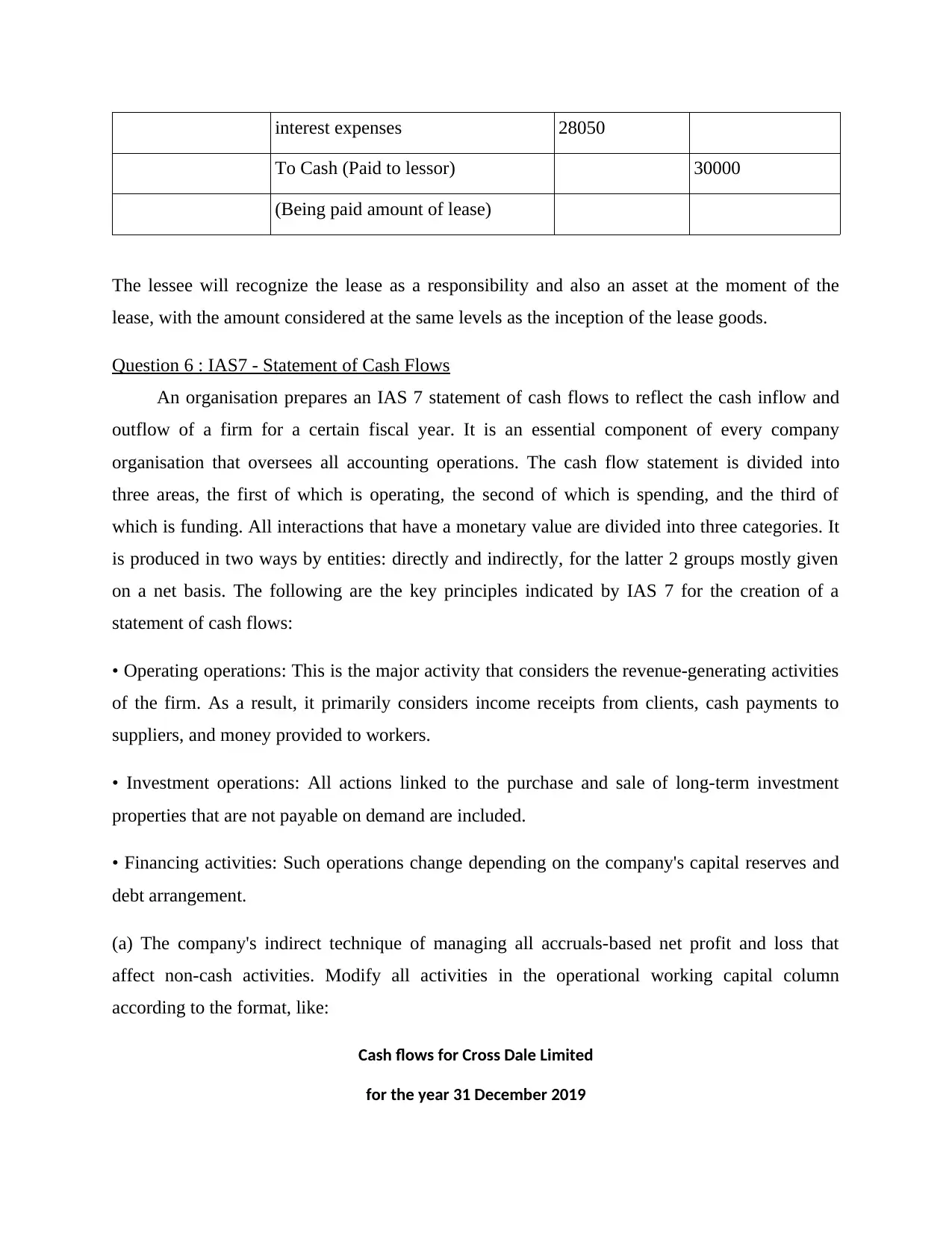
interest expenses 28050
To Cash (Paid to lessor) 30000
(Being paid amount of lease)
The lessee will recognize the lease as a responsibility and also an asset at the moment of the
lease, with the amount considered at the same levels as the inception of the lease goods.
Question 6 : IAS7 - Statement of Cash Flows
An organisation prepares an IAS 7 statement of cash flows to reflect the cash inflow and
outflow of a firm for a certain fiscal year. It is an essential component of every company
organisation that oversees all accounting operations. The cash flow statement is divided into
three areas, the first of which is operating, the second of which is spending, and the third of
which is funding. All interactions that have a monetary value are divided into three categories. It
is produced in two ways by entities: directly and indirectly, for the latter 2 groups mostly given
on a net basis. The following are the key principles indicated by IAS 7 for the creation of a
statement of cash flows:
• Operating operations: This is the major activity that considers the revenue-generating activities
of the firm. As a result, it primarily considers income receipts from clients, cash payments to
suppliers, and money provided to workers.
• Investment operations: All actions linked to the purchase and sale of long-term investment
properties that are not payable on demand are included.
• Financing activities: Such operations change depending on the company's capital reserves and
debt arrangement.
(a) The company's indirect technique of managing all accruals-based net profit and loss that
affect non-cash activities. Modify all activities in the operational working capital column
according to the format, like:
Cash flows for Cross Dale Limited
for the year 31 December 2019
To Cash (Paid to lessor) 30000
(Being paid amount of lease)
The lessee will recognize the lease as a responsibility and also an asset at the moment of the
lease, with the amount considered at the same levels as the inception of the lease goods.
Question 6 : IAS7 - Statement of Cash Flows
An organisation prepares an IAS 7 statement of cash flows to reflect the cash inflow and
outflow of a firm for a certain fiscal year. It is an essential component of every company
organisation that oversees all accounting operations. The cash flow statement is divided into
three areas, the first of which is operating, the second of which is spending, and the third of
which is funding. All interactions that have a monetary value are divided into three categories. It
is produced in two ways by entities: directly and indirectly, for the latter 2 groups mostly given
on a net basis. The following are the key principles indicated by IAS 7 for the creation of a
statement of cash flows:
• Operating operations: This is the major activity that considers the revenue-generating activities
of the firm. As a result, it primarily considers income receipts from clients, cash payments to
suppliers, and money provided to workers.
• Investment operations: All actions linked to the purchase and sale of long-term investment
properties that are not payable on demand are included.
• Financing activities: Such operations change depending on the company's capital reserves and
debt arrangement.
(a) The company's indirect technique of managing all accruals-based net profit and loss that
affect non-cash activities. Modify all activities in the operational working capital column
according to the format, like:
Cash flows for Cross Dale Limited
for the year 31 December 2019
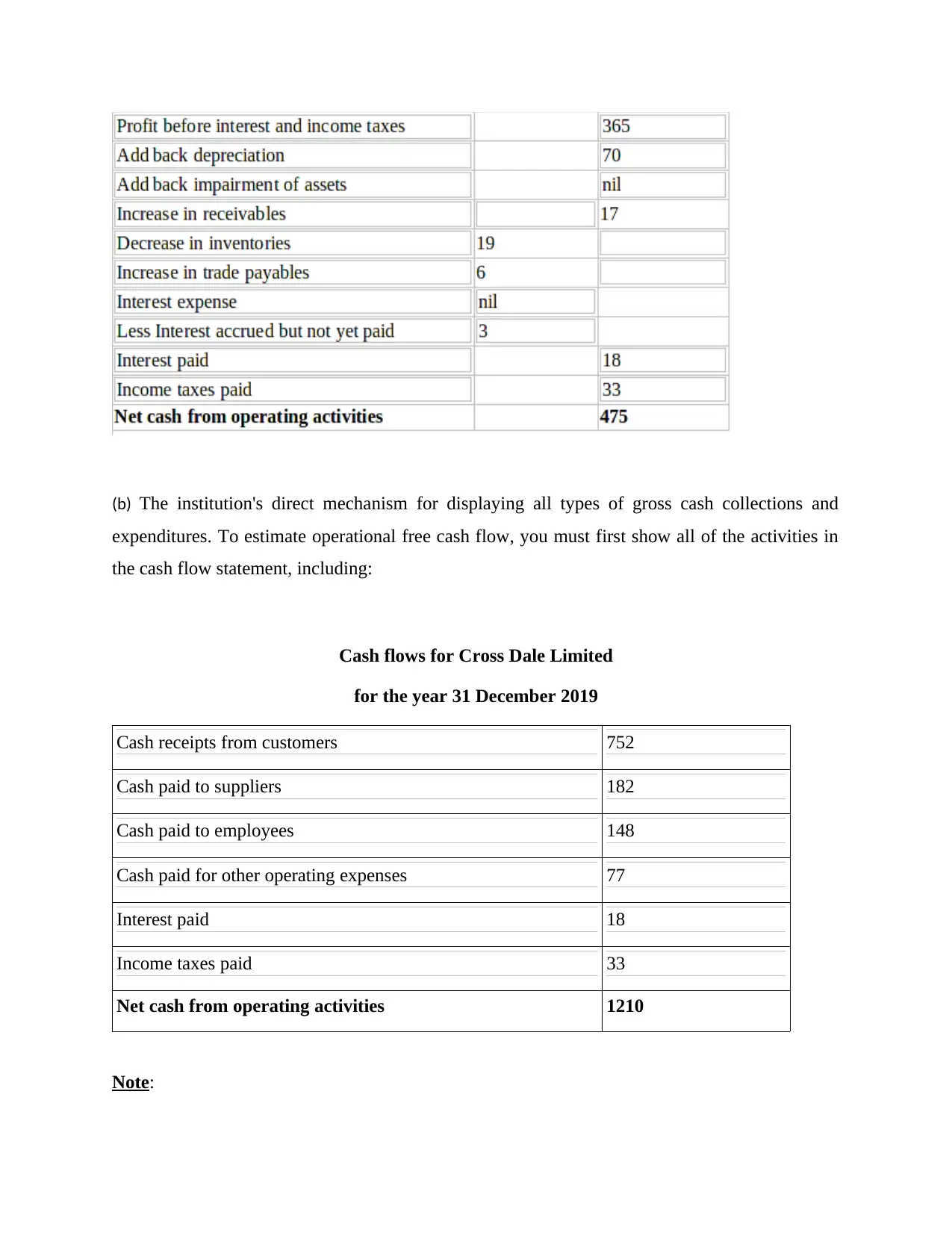
(b) The institution's direct mechanism for displaying all types of gross cash collections and
expenditures. To estimate operational free cash flow, you must first show all of the activities in
the cash flow statement, including:
Cash flows for Cross Dale Limited
for the year 31 December 2019
Cash receipts from customers 752
Cash paid to suppliers 182
Cash paid to employees 148
Cash paid for other operating expenses 77
Interest paid 18
Income taxes paid 33
Net cash from operating activities 1210
Note:
expenditures. To estimate operational free cash flow, you must first show all of the activities in
the cash flow statement, including:
Cash flows for Cross Dale Limited
for the year 31 December 2019
Cash receipts from customers 752
Cash paid to suppliers 182
Cash paid to employees 148
Cash paid for other operating expenses 77
Interest paid 18
Income taxes paid 33
Net cash from operating activities 1210
Note:
⊘ This is a preview!⊘
Do you want full access?
Subscribe today to unlock all pages.

Trusted by 1+ million students worldwide
1 out of 15
Related Documents
Your All-in-One AI-Powered Toolkit for Academic Success.
+13062052269
info@desklib.com
Available 24*7 on WhatsApp / Email
![[object Object]](/_next/static/media/star-bottom.7253800d.svg)
Unlock your academic potential
Copyright © 2020–2025 A2Z Services. All Rights Reserved. Developed and managed by ZUCOL.





